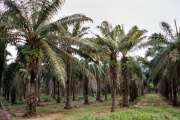Palm oil
Jump to navigation
Jump to search
Description
A yellowish semisolid oil obtained from the fruit around the nuts of the oil palm, Elaeis guineensis, native to Africa. Palm oil is composed of Palmitic acid (40.1%), Stearic acid (5.5%), Oleic acid (42.7%) and Linoleic acid (10.3%). It is used in the manufacture of soaps, chocolates, cosmetics, and candles. Palm oil has also been used to dress Leather made from goatskins. Oil extracted only from the palm nut is called palm kernel oil and is very similar to Coconut oil.
Synonyms and Related Terms
Elaeis guineensis; aceite de palma (Esp.); huile de palme (Fr.); olio di palma (It)
Risks
- Combustible.
- Bulk Apothecary: SDS
Physical and Chemical Properties
- Soluble in ethanol, ether, chloroform, carbon disulfide.
- Iodine number = 54.2
- Saponification number = 199.1;
| Melting Point | 30-35 C |
|---|---|
| Density | 0.915-0.952 g/ml |
| Refractive Index | 1.4578 |
Resources and Citations
- G.S.Brady, Materials Handbook, McGraw-Hill Book Co., New York, 1971 Comment: p. 572; Iodine number = 55; Saponification number = 205; palmitic acid (40-70%)
- Matt Roberts, Don Etherington, Bookbinding and the Conservation of Books: a Dictionary of Descriptive Terminology, U.S. Government Printing Office, Washington DC, 1982
- CRC Handbook of Chemistry and Physics, Robert Weast (ed.), CRC Press, Boca Raton, Florida, v. 61, 1980 Comment: melting point = 35.0, density=0.915, ref. index = 1.4578, iodine value=54.2, saponification value = 199.1
- The American Heritage Dictionary or Encarta, via Microsoft Bookshelf 98, Microsoft Corp., 1998
